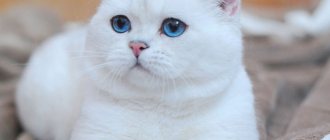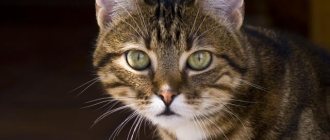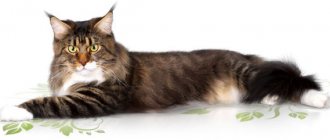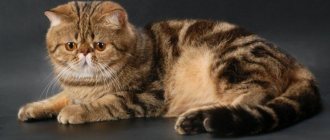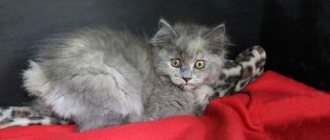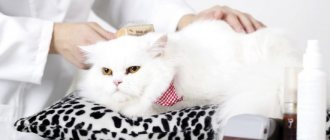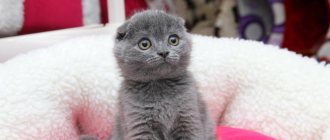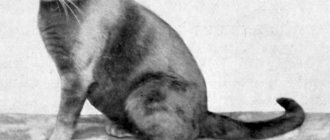Cat breeds with a flattened face
There are several brachycephalic breeds, differing in the degree of flattening of the head, standards of appearance, living conditions and character. Let's look at each of the breeds below.
Persian cat
This breed was one of the most popular in the world a couple of decades ago. Nowadays, interest in Persians has diminished, but representatives of this breed still have many fans. They are medium to large sized cats with powerful paws and long, thin, easily tangled hair. According to the degree of flatness of the muzzle, classic and extreme subspecies are distinguished. In classic Persians, the front part of the head is slightly elongated, while in extreme Persians, it is almost in the same plane as the eyes. Persians have a calm, domestic character and get along well with children, but they are much more dependent on their owners than cats of other breeds.
We recommend that you read the full article about Persian cats.
Himalayan cat
The Himalayan cat appeared in the 50s of the twentieth century in the USA as a result of crossing Siamese and Persian cats. Subsequently, only individuals with a pronounced Siamese color were allowed to breed, which allowed a breed with a predominant Persian exterior, but Siamese coloring and bright blue eyes.
Later in Great Britain, color-point dogs were bred from Persian and Himalayan breeds. They were distinguished from the Himalayans by their greater color intensity and elongated muzzle.
Now the independence of the Himalayan breed is not recognized by all associations. Some of them register Himalayan cats as Persians.
These cats will appeal to quiet and calm people. They do not like noisy places and dangerous games, but at the same time they treat children well and are very patient.
Read the full article about Himalayan cats.
Exocot
The exotic shorthair was bred by American breeders by accident. Scientists wanted to get a long-haired version of the American Shorthair breed and crossed animals of this breed with Persians, but the result was a Persian cat with short hair.
Most exotics are extreme cats with big eyes and soft, velvety fur. They are characterized by short strong legs, a squat body, developed muscles and a convex forehead. Due to their short coat length, exotic cats are much easier to care for than Persians.
Scottish fold cat
Scottish Fold cats, or, as this breed is also called, Scottish Fold, are cats of medium build (up to 6 kg) with a powerful body, a round head proportional to the body and hanging triangular ears that visually round the head even more. They have a more elongated muzzle than exotics. Among cat lovers, “Scots” have gained popularity due to the unusual shape of their ears, the constantly surprised expression of their eyes, their docile nature and devotion to their owner.
In some animals, upon reaching adulthood, the ears remain straight. They are classified as another, closely related breed - the Scottish Straight.
British shorthair cat
"British" belong to the category of brachycephals with short hair. These are strong, intellectually developed animals larger than the average cat. English legend says that the British Shorthair is descended from the Cheshire cat.
Although short in length, the British coat is quite thick. The most popular color of the British cat is blue with a silver tint. Cats with this color usually have amber eyes. Striped colors (tabby) and color point are also common.
Read the detailed article - British Shorthair cat.
Wild cat breeds with flattened faces
Among wild cats, brachycephaly is characteristic only of manul cats, hunter cats native to Central Asia. This animal is the size of a domestic cat, has a massive, squat body and thick tabby fur (necessary for camouflage). The flat shape of the muzzle helps the Pallas cat successfully hunt and carry prey: the flattened shape of the head allows the animal to breathe with the carcass in its teeth, and stronger jaws allow it to hold it more firmly.
The Pallas's cat is listed in the Red Book of Russia under category 3 (“rare species”).
Short tail
It is noteworthy that the presence of a tail in a “rudimentary” state or its complete absence in cats is a sign of “noble” origin (in contrast to the same domestic dogs, whose tails are docked deliberately - to fit the animals to the standards of a particular breed). It is worth noting that there are only a few types of short-tailed/“tailless” cat breeds, which include:
Kurilian Bobtail
a short curved tail approximately 5-9 cm long, resembling a fluffy pom-pom and characterized by mobility, a relatively small body with strong bones, developed muscles and limbs of medium length, a triangle-shaped head with medium-sized eyes corresponding to the color, short-haired or semi-long-haired, but in in any case, with a fluffy collar on the neck and chest.
more details
American Bobtail
a short and flexible tail from 2.5 to 8 cm long (it can be straight, curved, and slightly curled at the end), a body of medium length with an athletic build and strong paws proportional to it, a round muzzle with strong jaws and ears, an internal the surface of which is covered with long fluffy hairs, short or long hair, but always thick and slightly harsh.
more details
Japanese Bobtail
a short tail no more than 12 cm long (straight, curled, curved or in the form of a pompom), a long and lean body with a flat back and slender legs (the hind legs are noticeably longer than the front ones), a muzzle with large oval-shaped eyes and large, wide-set ears, soft and silky coat of medium length.
more details
Mekong Bobtail
a short and broken tail with a length of at least three vertebrae (but no more than a quarter of the length of the body itself), a strong and muscular body of medium size with long legs, a wedge-shaped head with medium-sized ears (with rounded tips) and slightly slanted eyes, always bright blue , short silky coat with minimal undercoat.
Karelian Bobtail
a short tail 4-13 cm long (can be either kinked or almost straight), a strong body with an even posture and proportional paws, a narrow head with a small strong chin and rather large ears with tiny “tassels”, short or long hair ( necessarily dense).
Kurilian Bobtail
“no, not a relative”
short tail 3-8 cm long (with pronounced kinks), strong build with a slightly arched back and powerful paws, large trapezoidal head with a powerful chin and proportional ears, short or long hair (very soft to the touch).
more details
Pixiebob
short straight (but possible kinks) tail about 5 cm long, large and muscular body build with powerful bones and a clearly defined arch on the back, large pear-shaped head, tightly knit and strong paws (the hind legs are noticeably longer than the front ones), short or moderately long hair with different color options, but always with small or medium spots throughout the body.
more details
Manx cat
they may either have no tail completely, or have a small “stump” hidden under the fur, or generally have a tail of normal length, a medium-sized round body with a round head, powerful limbs with well-developed muscles (the front ones are noticeably shorter than the back ones), round eyes with a slight slant, short and thick coat, like “plush”.
more details
Cymric cat
Kymrik
tailless breed (but there can be either a “stump” or even a full tail), a tightly built physique with a wide chest and an arched back, short front and long hind limbs (with heavy shins), thick hair of medium length.
more details
Features of these cats
The special shape of the head is called brachycephalic, as mentioned above. In fact, this phenomenon is a pathology.
According to scientists, the pathology is inherited from wild Pallas' cats, in which a similar head shape is found in nature. All representatives of cat breeds with a flattened shape have a wide head (the width is more than 80% of the height).
- Such cats look truly unusual, even in the present age, when people are accustomed to meeting purebred animals with brachycephaly;
- The jaws of cats with a flattened skull structure are much stronger than those of ordinary breeds;
- All cats of these breeds demonstrate an affectionate, friendly character and calm behavior in everyday life.
- The unusual shape of the skull results in noisy sleeping, eating, snorting and snoring;
- Shortened tear ducts and a special shape of the nose lead to increased secretions during stress or exposure to cold;
- Some breeds cannot eat their own food; owners spoon-feed such cats.
This is interesting! The special shape of the head in cats is called a doll head. The naive, childish expression on the faces of these breeds of cats seems to some to be an expression of malice or aggression.
Persian cat
At the beginning of the 2000s, Persian cats were the most popular in the world. Now the popularity of the breed has subsided, but Persian cats are still the most prominent representative of brachycephaly.
Persians have a medium body size, long legs, and fluffy fur. In some individuals, the nose is almost in the same plane as the eyes. Despite their apparent kindness and harmlessness, Persian cats are very strong.
The price of a purebred Persian starts from 2 thousand rubles.
Important! Persian cats should not be allowed outside for independent walks. Brachycephalics need constant supervision and are helpless in front of the outside world. There is a subspecies of the Persian breed - Himalayan cats
Not all associations recognize the breed. The Himalayan is registered as a Persian breed. Himalayan leather originated from Persians crossed with Siamese. The breed has the color of a Siamese cat and a characteristic face with brachycephaly
There is a subspecies of the Persian breed - Himalayan cats. Not all associations recognize the breed. The Himalayan is registered as a Persian breed. Himalayan leather originated from Persians crossed with Siamese. The breed has the color of a Siamese cat and a characteristic face with brachycephaly.
Best articles: TOP 10 Fathers in the animal world
Exocats
The Exotic Shorthair is a breed created by chance. In an attempt to lengthen the coat of the short-haired American breed, the individual was crossed with a Persian. The result was an exotic shorthaired cat. Now this breed is independent, has a flattened face and fluffy, short hair.
The breed has a prominent forehead, a stocky body and strong short legs. The shape of the head is extreme, i.e. eyes and nose are at the same level.
Representatives of an exotic breed of cats cost from 7 thousand rubles in the CIS countries.
Scottish Fold
The Scottish Fold breed has gained popularity due to its triangular, bent ears. Scottish fold cats reach a weight of 6 kg and have a strong, rounded body. These cats have a flattened muzzle, although the convexity of the nose is much greater than in previous breeds.
Some representatives of the breed straighten their ears with age. They are classified as a different breed - Scottish Straight. According to the canons, only straight-eared pets can be crossed with fold-eared ones. Crossing two lop-eared individuals leads to genetic mutations and diseases in the offspring.
Cats without a pedigree of the Scottish Fold breed cost from 3 thousand rubles.
Important! At shows, Scottish Folds may be disqualified for having too large a tail and hind legs. Recently, such a structure has been considered a disadvantage of the animal.
British Shorthair
Looking at the photo of the British man, it is impossible not to fall in love. These are amazingly beautiful brachycephals with short, smoky hair. British Shorthair cats are very smart and have the mentality of real English aristocrats.
The British have muzzles that are elongated enough for the cat to feed on its own and avoid the problems that Persians have. However, some form of brachycephaly is present in British cats.
The average price for a British Shorthair kitten is 10 thousand rubles.
In the wild, a flat muzzle is characteristic of only one member of the cat family - the Pallas's cat. This is a rare species listed in the Red Book. The flattened shape of the skull is due to the need to hunt specific prey and carry it to its lair.
Domestic cats with flat faces almost do not resemble the ancestor of the Pallas cat in appearance.
How they appeared and what they are
Some scientists argue that Persian cats have existed since the founding of Persia. Although references to charming cats with luxurious fur date back to the 17th century.
They first spread to the court of the French king thanks to Cardinal de Richelieu. It was he who introduced the fashion for such exotic animals at that time.
The emergence of the Persian Longhair dates back to 1887. Then they were divided into several subspecies, which served as an incentive for the creation of clubs for cat lovers. And at the beginning of the 20th century they became the first breed officially recognized by the English Felinological Association.
In the 20s, a subtype of the Persian appeared - extreme, and in the 50s, by crossing it with a Siamese, the Himalayan cat was created. In the 60s, a Persian cat gave birth to kittens from an American Shorthair, which were later called Exotic Shorthairs. In the Soviet Union, they first learned about such pets in 1980, and their breeding began in 1991.
Among the distinctive features of snub-nosed cats are the following characteristics:
- brachycephalic muzzle with a depressed nose;
- cheeky head, the width of which is more than 80% of the height;
- stocky build with a small body and short powerful legs;
- small ears widely spaced on the head;
- thick plush fur of medium or long length.
Such pets are very affectionate and pliable, friendly with others, and especially with children. They become very attached to their owner, with whom they like to spend as much time as possible.
Exotic Shorthair
In shortened form, this breed of cat with a flattened muzzle and large eyes is called exotic. She owes her appearance to the crossing of Persians with an American shorthair cat. In appearance, exotics are very reminiscent of extreme Persians, but unlike the latter, they have short, soft hair, which saves owners from the need to spend a lot of time on regular grooming. Among the characteristic features: strong short legs, an expanded chest and large size (the weight of some animals exceeds 8 kg). The color of representatives can be very diverse, from white and black to noble blue.
The cute plush appearance of the exotic cat fully matches its character. These pets differ from their Persian ancestors in a more affectionate, playful disposition, without unnecessary aggression, and therefore are considered an ideal option for families with children. They rarely speak, love their owner very much and get along without problems in the same territory with other animals.
Himalayan
Another breed of cat with a short nose is the Himalayan, obtained from crossing Persians with Siamese. It is recognized only by the TICA and CFF associations. Others consider it a subspecies of the Persian and register it that way.
In addition to the snub nose, the distinctive features of the Himalayan's appearance include bright blue eyes, a large body with short legs and increased fluffiness. The coat color is color point with transitions from beige on the body to dark brown on the nose, ears, tail and limbs.
Pets of the Himalayan breed are distinguished by a calm, even lazy character: they rarely play, and like to sleep more than others. Due to this lethargy, they can be called ideal pets for cuddling.
With some stretch, British Shorthair and Scottish Fold cats can also be considered breeds with a flat nose. The brachycephalic type of skull is not as pronounced in them as in the Persians, Exotics and Himalayans presented above.
Devon rex
Hairless breeds took all the top positions in this ranking. Devon Rex is an exception! He has fur! A cat with a unique exterior resembles an alien. So he doesn’t look like the usual cute earthly cats. The thin body is covered with a suede curly fur coat. The awkward neck is completed by a tiny head with huge ears. And the expression of his elven face cannot be confused with anyone else.
In life, these pets are incredibly playful; cats occupy all the owner’s free time. As befits real space aliens, Devon Rexes are attracted by heights. Animals seek out and occupy the highest point in the room. It could also be the owner’s shoulders, if one is not found. Cats of this breed are extremely smart, easily learn commands, and perform tricks like a dog. The only command that Devons do not accept is “No!” when it comes to food.
What is the price
Kittens in Russia are offered for 25,000 – 75,000 rubles; in Ukraine – for 5,000 – 17,000 UAH.
Author's comment
These alien cats do not know moderation when it comes to food, often behave as if they have not eaten for a week, and do not disdain food from the human table.
Character
Persians are absolutely domestic cats. Representatives of this breed are very attached to people. They get along well with children and endure the squeezing and clumsy stroking of babies with honor. The Persian cat singles out the owner, in whose absence he can be very worried: refuse to take food and water, sit and lie in one place until he comes. She tolerates loneliness very hard and can even follow on the heels of her owner, annoying him by constantly “getting under her feet.”
The Persian cat takes great care of its offspring. At the same time, she allows the owner to participate in caring for the babies. By temperament, Persians can be both active and calm, but aggressive ones are very rare. Kittens and young cats are quite playful. If you play with them, this playfulness can be maintained throughout the pet's life.
They treat other pets well. Persians do not mistake small rodents and birds for their prey, so they coexist peacefully with each other.
Persians get along well even with rodents and birds
They may shy away from guests at first, but in general they are friendly towards strangers.
There are rumors about Persian cats that they are extremely quarrelsome with people, vindictive, stupid and lazy. But this is absolutely not true. The Persian lived in our house for more than 12 years. This handsome man was very smart. This is strange to hear about a cat, but every day he met his husband, whom he recognized as the owner, at the threshold of the door, like a dog. He got along well with a small child. He never scratched the baby, although in his place another cat would have been tired of the constant tugging of its tail.
Brachycephalic cat breeds
- British Shorthair;
- Scottish lop-eared;
- Himalayan;
- exotic;
- Persian
Exotic cat
CFA (Cat Fanciers Association) annually publishes a ranking of the most popular breeds. For many years, kittens with flattened faces have been at the top of the rankings, which indicates their popularity.
British Shorthairs with a slightly flat nose
The British cat is characterized by a round, plump muzzle, slightly sagging cheeks, and small, neat ears. The animals have a squat, dense body and strong limbs.
In British cats, brachycephalic syndrome manifests itself to the least extent. They are distinguished by a short, wide and straight nose, which forms a vertical line with the chin.
British Shorthair cats are self-sufficient, they tolerate loneliness calmly and do not like noisy companies and active games. They are great for singles who spend a lot of time at work. These animals have a sense of self-esteem, so they expect respect from others.
https://youtube.com/watch?v=XNYtB9Ill8o
Scottish Fold: almost normal profile
Representatives of the Scottish Fold breed have a slightly flattened muzzle, and their profile is close to normal. The calling card of the Scottish Fold is drooping ears and a surprised expression in the eyes. The weight of an adult animal is 4–5 kg, the physique is correct and powerful. The head is round, proportional to the whole body. Hanging ears visually make the head even rounder.
Scottish fold cat
Scots are always loyal to their owners, they are obedient, easy to train, calm, and rarely release their claws. At birth, babies' ears are straight and erect; they droop later. Sometimes this does not happen; such individuals are classified as a related breed, the Scottish Straight.
Some representatives of the breed have thicker tails than normal, which is considered their main and only drawback. Animals with thick tails have too massive hind limbs, which interferes with normal movement.
Best articles: The hottest and coldest planets in the solar system
Luxurious Himalayan cat: Persian face, Siamese color
The Himalayan cat is an amazing, noble animal, a direct descendant of the Persian. The breed was bred artificially by crossing Persian and Siamese cats. The cats inherited the appearance of the Persian and the royal coloring of the Siamese. The breed is officially recognized by only two felinological associations - TICA and CFF.
Himalayan cat
Distinctive features of appearance and physique:
- rich blue eye color;
- color point coat color - dark paws, tail, muzzle and ears, everything else is light;
- long fluffy fur;
- large rounded body and short limbs.
Himalayans have a calm, gentle character. They are similar to Persians, but more active, they love to play and run after toys. They get along well with children as long as they don't cuddle them too much.
Plush big-eyed exotic
The American Shorthair Exotic cat, or Exotic, is an unusual cross between the American Shorthair and the Persian breed. Exotics are surprisingly cute, looking like plush toys. They inherited the anatomical features of the Persians - a flattened muzzle, an upturned nose, neat ears, and large round eyes. Exotics have a dense, squat body and short limbs.
Exotic
These are affectionate, calm, flexible and very playful animals. In adulthood, they remain active and enjoy playing with their owner. Very attached to people. Exotics are quiet, rarely meow and do not bother their owners. They get along well with people and other animals, including dogs.
Unlike Persians, who have long, thick fur, exotics are easy to care for. Caring for plush short fur does not require much effort or time. That is why exotic cats are popularly called Persians for lazy people.
Classic brachycephalic – Persian
The Persian breed is very common in the post-Soviet space. Cats look very large due to their incredibly fluffy fur. These are lazy, clumsy animals that love peace.
Persian cat
Thick coat requires careful and regular care. It is necessary to comb your pet frequently to avoid the formation of mats that will have to be cut off. A well-groomed coat looks gorgeous, but it takes time and patience.
Exterior of a Persian according to the breed standard:
- large body, developed muscles;
- small triangular ears;
- weight of an adult cat – up to 7 kg;
- round head;
- flattened muzzle and upturned nose (at eye level);
- large round eyes yellow or green;
- short limbs.
Exotic
Or an exotic shorthair cat. Outwardly it looks like a short-haired Persian. Only her size is smaller and her face is much cuter. Short hair does not require daily grooming and makes keeping the animal easier. The character of these cats is much friendlier than the Persian. They are playful and affectionate and love children.
Colors, like the Persians, can be varied. Up to noble blue. The face is truly doll-like and evokes only tenderness. An excellent breed for a family with children. Exotics are cartoon cats. Children will definitely be delighted with them, and parents will not have to spend a lot of time looking after them.
Breeds
Brachycephaly is a characteristic feature of some purebred cats. Let's take a closer look at the most popular of them.
Persian
The history of the luxurious Persian cat goes back hundreds of years. At all times, representatives of this breed have been incredibly popular and in demand.
Persians have a slightly upturned nose, and their eyes are large and round. Typically, these cats have long and silky hair, which is very pleasant to the touch. Petting these cute creatures is a pleasure. The Persians have a squat body and short legs. The coat color of these pets can be very diverse.
There are several subspecies of Persian cats. They differ in the following characteristics:
- classic type - in such pets the nose is located just below the eye line;
- modern type - in these animals the edge of the nose is located in line with the lower eyelid;
- extreme type - if the cat is of this type, then it will have a characteristic concave nose, located at the same level as the inner corners of the eyes.
All these cats are true homebodies. They have a calm and balanced character. Kittens can be playful, but as they grow older they become more peaceful and sedate.
Exotic
Otherwise, this breed is called exotic shorthair. Its representatives are the result of crossing American Shorthair and Persian cats. Externally, these individuals are very similar to representatives of the Persian breed. They differ only in their short fur.
Exotics are most similar to extreme Persians. They also have an upturned nose, expressive eyes and a squat build. The paws of these cats are also not very long. The character of these pets is considered absolutely calm, peaceful and playful.
Exotics have always been affectionate pets, for which many fans of cats with flattened faces love them. They rarely speak and love their owner very much. In addition, exotics coexist seamlessly in the same territory with other domestic animals.
Himalayan
The Himalayan cat looks chic and unusual. True, not all organizations have yet recognized it as a separate breed. Some experts consider it one of the subspecies of the Persian cat breed.
These charming animals are distinguished by the same flattened muzzle, expressive blue eyes and long hair. The color of the Himalayan cat is the same as that of the Siamese. These cats behave very calmly and do not get involved in fights or conflicts.
British Shorthair
These cats are very popular and widespread. The main distinguishing feature of the breed is that their flattened muzzle is wide and rounded with slightly downturned cheeks. The body of the British is also squat, and the limbs are short. There are many color options for furry pets. Classic dogs are considered to be those whose coats are blue, cream, red, black, lilac or tabby.
British Shorthair cats have an easy-going nature. They behave intelligently and carefully, demonstrating excellent upbringing. These animals can easily endure prolonged loneliness. Kittens love to play and act funny. Britons are patient animals and only show their claws in exceptional cases.
Scottish lop-eared
Such animals have a non-standard structure of the auricles - the ears seem to lean forward and tilt down. The closer the ears touch the head, the more valuable the cat is considered. In animals, the muzzle can also be flattened, but not at all like that of exotics or Persian beauties. The body of lop-eared aristocrats is distinguished by a more powerful build. They have a short coat that is soft.
The Scots are unpretentious when it comes to caring for them. Their character is balanced, so usually such pets behave absolutely calmly. These individuals quickly become attached to humans. Scottish fold kittens are big fans of playing to their heart's content, but they are still amenable to training and education. Scots often stand on their hind legs or sleep on their backs - at such moments they look very cute and funny.
Best articles: What types of fish live in the Black Sea - names, photos and characteristics
Abyssinian
The direct ancestor of the Abyssinian is considered to be the African wild cat, which previously lived in Ethiopia. This area was in the past called Abyssinia, hence the name of the breed. In 1868, the first such cat was brought to England by the captain of a warship. He became the founder of the breed. The body shape of the Abyssinians of that time was completely different, and any colors were allowed. But over time, Abyssinian cats became what we are used to seeing them. The breed was officially registered in 1904, at which time its modern standard was established. During the First World War, the Abyssinians almost disappeared, but they were preserved in the United States. And these cats returned to Europe only after the end of the next war.
| Sign | Description |
| Body type | The sizes are average. The body is very flexible, slender |
| Head | Triangular shape. Round muzzle |
| Eyes | Almond-shaped. Color - amber, hazel or green |
| Ears | Wide at the base, rounded at the ends. Tassels are allowed |
| Tail | Long, thin |
| Limbs | Muscular, medium size. Paws are large and round |
| Wool | Short and soft. Its peculiarity is that each hair is colored in several shades at once. This is called ticking |
| Color | Four types of color are allowed: sorrel (base color is bright red, ticking is light brown); faun (main color - cream, ticking - beige); blue (main color - red, ticking - gray-blue); wild (ground color: reddish-brown; ticking: black) |
Abyssinian cats are very active, active and energetic. They do not require the owner’s attention all the time, but they do need time. This is especially true in cases where a person has been away from home for a long time (for example, at work).
Maine Coon
This breed is a semi-long-haired cat. The breed was bred in the USA, and is one of the largest purebred representatives in the world, created to live next to humans. This is a large breed of cat, with an extraordinary appearance, a variety of colors and an affectionate character.
The Maine Coon first appeared in Northeast America, in the state of Maine, about a hundred years ago. Part of the animal's name is associated with this area. The second component of the name in translation means raccoon or lynx, which is explained by the similarity of the fur coat with the coat of a raccoon. And with the presence of tassels, cats resemble a lynx.
The breed developed in northern climates, which explains the appearance of wide bones and long hair between the pads on the paws. Size does not match weight. Males weigh more than 10 kg. This breed of tasseled cats entered the Guinness Book of Records thanks to an amazing specimen weighing 16 kg.
Character
The Maine Coon is distinguished by its character and interesting features:
This ear-tufted cat adores her family and doesn't require much attention herself. They do not like loneliness; if you have to leave her alone for a while, you need to purchase various toys for the cat so that she does not get bored before the owners arrive. They love water and water procedures very much. There should always be a bowl of water next to the food for your pet to splash into. Maine Coon is able to communicate using different sounds. In addition to meowing, they make sounds similar to squeaks and trills. They have developed body language. If a cat wants to express a special reverent attitude, it hits its head. The breed is adapted to living in any climatic conditions. They can withstand winter cold and snowy weather without problems. Very friendly. The color of cats of this breed with tufted ears varies in 75 different color combinations. The breed includes both ginger cats and individuals with a chocolate color; lilac-colored specimens are possible, although these variations are recognized as a deviation from the standard and are not the norm for this species.
Maine is a coon with a half-meter tail, long hair, wide strong paws, powerful muscles and a large head. The cat's head is elongated, high cheekbones, triangular ears with tufts. The eyes of Maine Coon cats are oval-shaped, the color should be in harmony with the coat.
Care
Caring for this breed is easy:
- The coat needs to be brushed daily; Provide her with a scratching post;
- For food and water you need to place separate bowls, preferably made of glass or stainless steel;
- It has a tendency to develop periodontal disease; to prevent the disease, you need to regularly brush your pet’s teeth.
- The animal should be provided with its own corner, as it needs privacy from time to time. When the cat is in its corner, you should not touch it, so it will feel safe.
- It is recommended to feed the Maine Coon dry food, which will keep the teeth in good condition.
You can add to your diet:
- Raw beef;
- Cottage cheese;
- Quail eggs;
- Boiled chicken.
The Maine Coon is a breed of cat with tassels, included in the list of the most expensive species in the world ($4,000 to $80,000).
Siberian cat
Classics of the genre. Warm fur coat and bushy tail, massive build. It is worth noting the teeth: they are incredibly strong. If a cat wants to bite, he will really bite and it will hurt a lot.
There are tufts between the toes, indicating a wild forest origin. Development is slow, the cat develops only by 5 years. The front legs are shorter than the hind legs, which gives them agility and grace.
The special charm of the muzzle is given by slanted eyes, long eyebrows and mustaches, often curled like a spring.
An excellent option for people prone to allergies. The fact is that the saliva of a Siberian contains a minimum of allergen.
You especially need to take care of your eyes, they often fester. The coat is brushed 3 times a week.
A little selfish. They play when they want, they will not tolerate violence against the cat’s personality. Avid lovers of heights: every shelf will be examined, even the closet will not remain untouched. And they step softly, without dropping anything.
They hunt well, catching both mice and rats. They treat strangers poorly and defend their territory. According to a typical Siberian, the best place to rest is near the battery, with the paws spread and the tail extended.
Price: from 5000 rubles.
Do you want to know about other cats, such as caracals with tufted ears?
Watch the video:
https://youtube.com/watch?v=_VBgdHblChA%3F
History of the popularity of Grumpy cat
global $ads_google;
//data-ad-slot=”2475549904″ $ads_google = empty($ads_google) ? false : true; ?> if ($ads_google == false) {?> $ads_google = true; ?> } ?> The cat's dissatisfied face made her famous, making her an Internet star. The owner of the animal was able to quit her job as a waitress and began to make good money from the popularity of her pet.
With the growing popularity of Tardar, there was a need to create a page on Facebook in her name, and in 2013, the pussy won the Webby Award in the Meme of the Year category.
The beginning of 2013 was spent creating two videos advertising cat food, where the leading role went to the now famous Tardar. Then an offer came from the company Broken Road, planning to make a feature film starring the gloomy celebrity. It is expected to repeat the success of the film "Garfield".
Surprisingly, the book “Grumpy Cat: A Grumpy Book” was soon published. She quickly found her readers.
Resourceful owners filed a patent and trademark, and even won a lawsuit for a large sum due to the unauthorized use of their pet's image. In addition to releasing the Grumppuccino coffee drink, Grenade Beverage used the cat's image for a series of T-shirts and a blend of roasted coffee beans.
In 2014, the celebrity became popular on the social network VKontakte and Instagram. The gloomy, funny cat has more than 2.4 million subscribers; several dozen and sometimes hundreds of thousands of people view the pages of the fluffy gloomy cat every day and like it!
The happy owners earned about 100 million dollars from Grumpy's , so despite the pet's gloomy appearance, the owners cannot be called gloomy.
American Curl
This breed of cats with round ears is now at the peak of popularity; besides, the pets themselves have not only an unusual appearance, but also a friendly disposition, they are very sociable, devoted to their owner, and play with pleasure. Distinctive features of the appearance of these animals are as follows:
- Elegant graceful physique.
- Flexible long tail (its length matches the size of the body).
- The average weight is small - 5-7 kg (males), 4-5 kg (females).
- The coat can be either long or short, with long-haired Curls being the most popular among breeders.
But the most striking detail of the pets’ appearance is their rounded, curved ears, the unusual shape of which is explained by a mutation of the hard ear cartilage. In the photo you can see that the inclination of the shell is individual for each cat, it can be 180°, or it can have a more modest value - 90°. A characteristic feature of the breed is that the round tip should not exceed 1/3 of the ear. One of the difficulties faced by pet owners is the fragility of the ear cartilage, so you need to be very careful with your pet.
Choosing a puppy
The price range of the breed has a lower limit of 2,500 rubles. This will be a puppy without documents, it is possible that pure blood can be forgotten, and there will be no question of patronage from the breeder. Puppies from breeders with documents cost from 23,000 to 35,000 rubles. Here you can already be sure of the quality of the litter and that the documents will not be fake.
Puppies from nurseries, with the appropriate pedigree and prospects for exhibitions and matings, will cost from 40,000 rubles. The price of the breed is due to its popularity; it can also explain the huge number of advertisements from private individuals who in no way guarantee the purity of the bulldog’s blood. In any case, remember that a purebred English bulldog is a “gentleman,” but a puppy from a private dog breeder may not become one.
Minuses
- Since the flattened shape of the face is not natural for cats, some problems arise from this. And sometimes in the literal sense of the word. These cats often have problems with nasopharyngeal congestion. A cat may snore and snort in its sleep. It's noisy.
- The brachycephalic type of muzzle in some people causes associations with an angry facial expression. This cat seems to be constantly dissatisfied with something. Or, on the contrary, it looks very naive. This form is also called a “doll” because it can resemble a child’s face. The associations are completely contradictory to each other, but they do exist.
How to choose a healthy kitten with a flat face?
When choosing a kitten with a flattened face, you should not chase extreme exoticism. The more pronounced the brachycephalic syndrome, the greater the chance of acquiring many problems along with the kitten. It is worth looking at the parents of the future pet, finding out if they have any diseases characteristic of such breeds, listening to their breathing, and observing the baby himself. A healthy cat is active, playful and curious. He has clear eyes without discharge, a moist, cool nose and free breathing.
Source
Persian
Long silky hair (of any color), round green or yellow eyes, a flattened muzzle with an upturned nose - these are the characteristic features of a purebred Persian. His character can be either capricious or pliable, calm.
Thanks to the long, thick fur, the size of the Persian cat visually increases, but after a bath you can be very surprised by the size of the pet, because they will be much smaller than it seems.
Among the representatives of this cat breed there are also their own types:
- Classic (nose slightly below the eye line).
- European (the edge of the nose is at the same level as the lower eyelid).
- Extreme (nose in line with the inner corners of the eyes).
